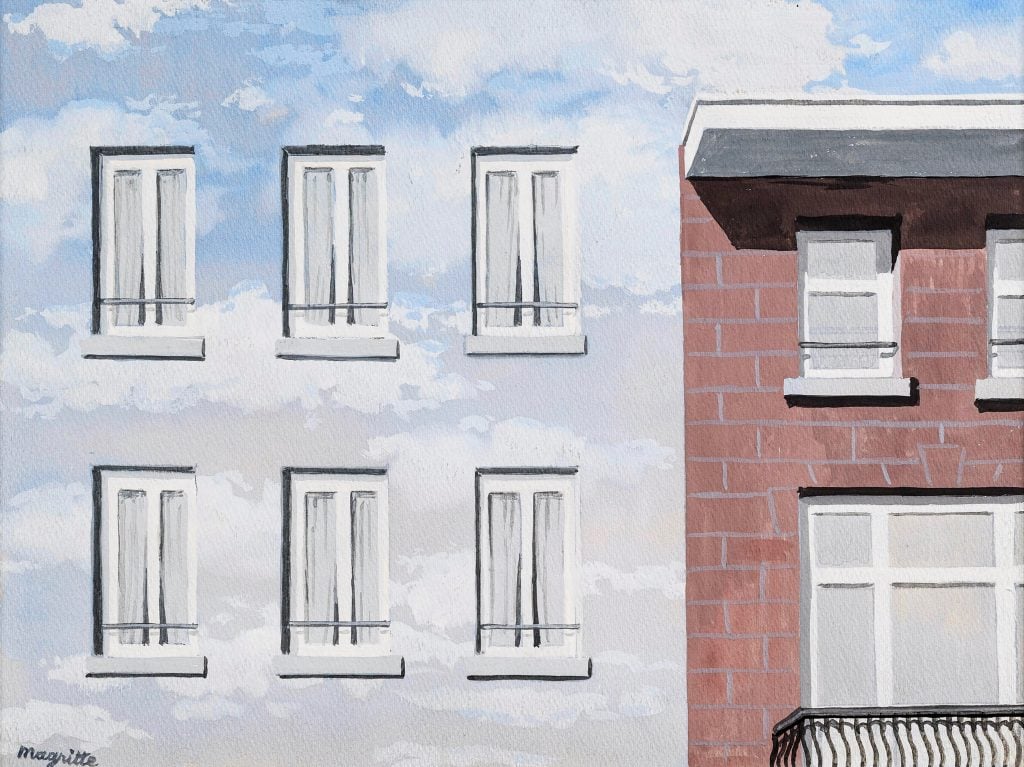René Magritte, a leading figure in the Surrealist movement, is renowned for his ability to provoke thought and challenge perceptions through enigmatic and evocative imagery. One of his significant works, L’État de veille (The State of Wakefulness), painted in 1958, encapsulates his characteristic style and philosophical approach to art. This piece reflects his exploration of the boundaries between reality, dreams, and the human condition, demonstrating his mastery of symbolism and allegory.
Background on René Magritte
Born in 1898 in Lessines, Belgium, René Magritte became a central figure in 20th-century art, revolutionizing the way people perceive and interpret visual imagery. Unlike some of his contemporaries in the Surrealist movement, Magritte’s works were marked by their deliberate simplicity and clarity. His imagery often combined everyday objects in unconventional contexts, encouraging viewers to question the relationship between reality and representation.
Magritte’s art was deeply philosophical, heavily influenced by his interest in language, semiotics, and the subconscious. This intellectual depth is evident in L’État de veille, which exemplifies his ability to distill complex ideas into compelling visual forms.
The Composition of L’État de veille
In L’État de veille, Magritte explores the tension between wakefulness and sleep, reality and illusion. The painting depicts a mysterious figure reclining or hovering within an ambiguous space that seems to blur the boundaries between the physical and the metaphysical. The visual elements of the painting are deceptively simple but deeply symbolic, inviting multiple interpretations.
Key features of the composition include:
The Setting: The background is undefined, a hallmark of Magritte’s style. The absence of a concrete setting heightens the painting’s dreamlike quality and focuses attention on the conceptual interplay between the figure and its surroundings.
Symbolism of Objects: In many of Magritte’s works, objects are placed in surreal or unexpected contexts. While L’État de veille might not contain explicit everyday objects, its overall composition evokes a sense of duality and ambiguity.
Interpreting the Title: L’État de veille
The title, The State of Wakefulness, is crucial to understanding the painting’s conceptual framework. Magritte often used language to deepen the mystery of his works rather than clarify them. Here, “wakefulness” can be interpreted in several ways:
•Literal Wakefulness: The physical state of being awake as opposed to asleep, suggesting a focus on human consciousness and awareness.
•Metaphorical Wakefulness: The intellectual or philosophical awareness of one’s existence, hinting at existential themes.
•Transition Between States: The title might also reference the in-between state of wakefulness and dreaming, a space where reality becomes fluid and imagination takes over.
Magritte’s deliberate ambiguity encourages viewers to consider their own interpretations, aligning with his belief that art should challenge and expand the viewer’s perceptions.
Themes and Philosophical Undertones
Duality of Consciousness
Magritte was fascinated by the interplay between reality and illusion, and this theme is central to L’État de veille. The painting explores the dual nature of human consciousness, highlighting the tension between rational thought and the surreal, dreamlike aspects of the mind.
The Uncertainty of Reality
As with many of Magritte’s works, L’État de veille questions the nature of reality. The undefined setting and mysterious composition invite viewers to reflect on the fluid boundaries between what is real and what is imagined.
Existential Reflection
The solitary figure can be seen as a representation of the human condition, grappling with questions of existence, purpose, and awareness. This existential theme is a recurring motif in Magritte’s art, reflecting his interest in philosophy and human psychology.
L’État de veille in the Context of Magritte’s Oeuvre
L’État de veille belongs to Magritte’s later period, during which he refined his unique style while continuing to explore complex philosophical ideas. By 1958, Magritte had already established himself as a master of Surrealism, creating iconic works such as The Treachery of Images (Ceci n’est pas une pipe) and The Son of Man.
In comparison to these more famous works, L’État de veille is subtler in its execution but equally profound in its thematic exploration. It demonstrates Magritte’s continued commitment to challenging conventions and expanding the boundaries of art and thought.
The Influence of Surrealism
Magritte’s involvement in the Surrealist movement profoundly influenced his approach to art. Surrealism, which emerged in the early 20th century, sought to explore the unconscious mind and challenge traditional notions of reality. Led by figures like André Breton, the movement emphasized the power of dreams, imagination, and the irrational.
Magritte’s unique contribution to Surrealism was his ability to juxtapose ordinary objects and scenes in extraordinary ways. Unlike the more abstract or chaotic works of some Surrealists, Magritte’s paintings were characterized by their clarity and precision, which made their surreal elements all the more striking.
In L’État de veille, this clarity is evident in the clean lines and simple composition, which contrast with the painting’s enigmatic atmosphere. This juxtaposition is a hallmark of Magritte’s style and a key reason why his work continues to captivate audiences.
Legacy and Impact of L’État de veille
Although not as widely recognized as some of Magritte’s other works, L’État de veille is an important piece in his oeuvre, showcasing his ability to merge visual simplicity with intellectual depth. The painting has inspired countless interpretations, reflecting its timeless appeal and relevance.
Magritte’s exploration of wakefulness, consciousness, and reality in L’État de veille resonates with contemporary audiences, who continue to grapple with similar questions in an increasingly complex world. The painting serves as a reminder of art’s power to provoke thought, challenge perceptions, and inspire introspection.
Impression
René Magritte’s L’État de veille (1958) is a masterful example of Surrealist art, blending simplicity with profound philosophical themes. Through its enigmatic composition and evocative title, the painting invites viewers to explore the nature of consciousness, reality, and the human condition.
As one of the most influential artists of the 20th century, Magritte left an indelible mark on the art world, and L’État de veille is a testament to his enduring legacy. By challenging perceptions and encouraging introspection, the painting remains a powerful and thought-provoking work, as relevant today as it was in 1958.
No comments yet.








